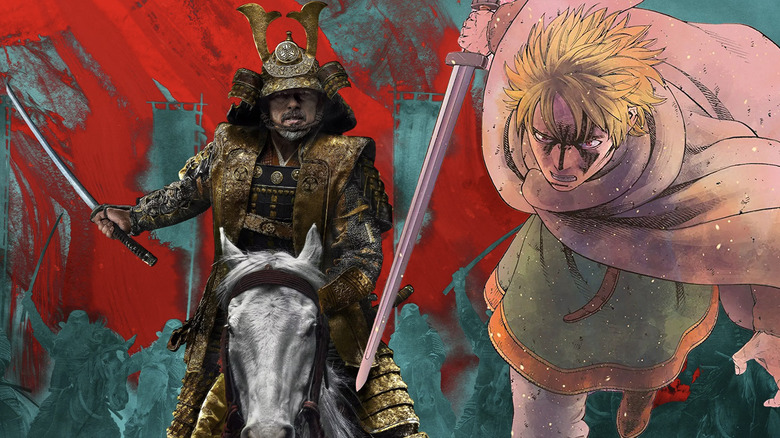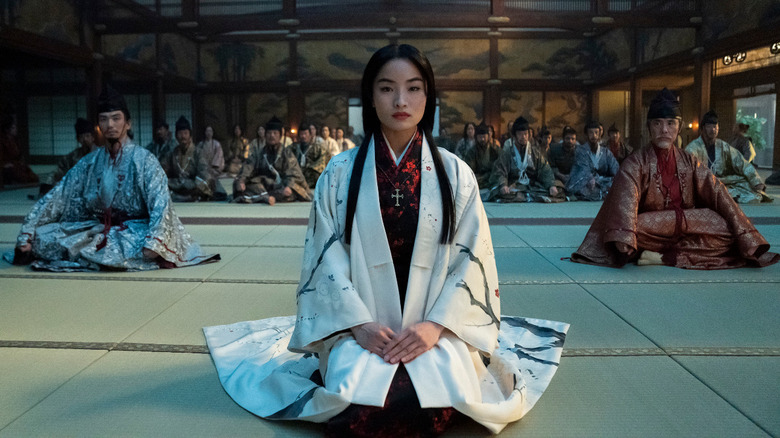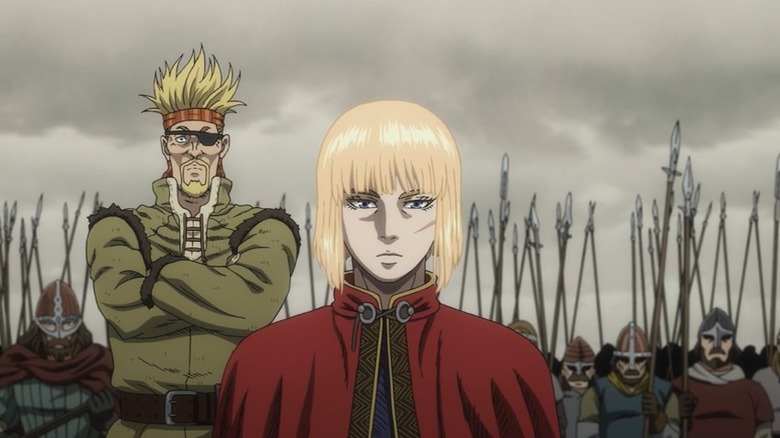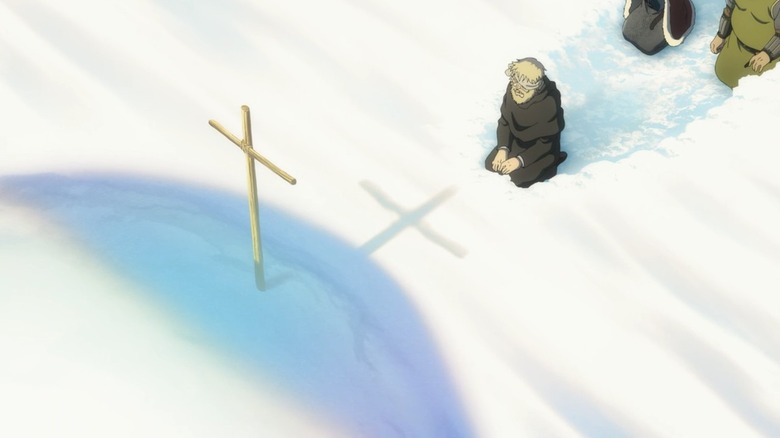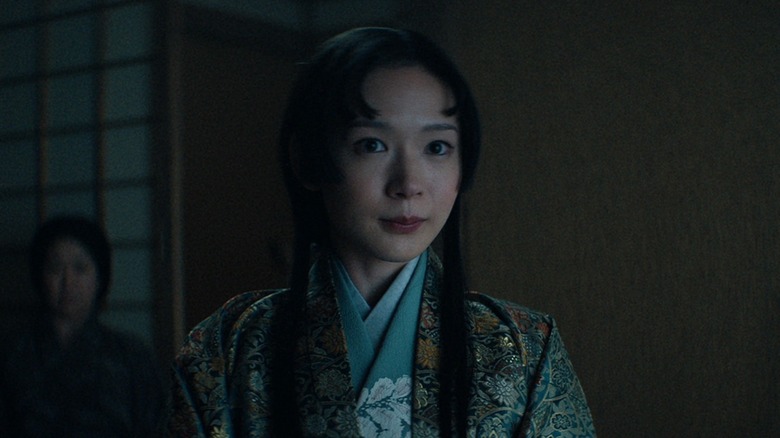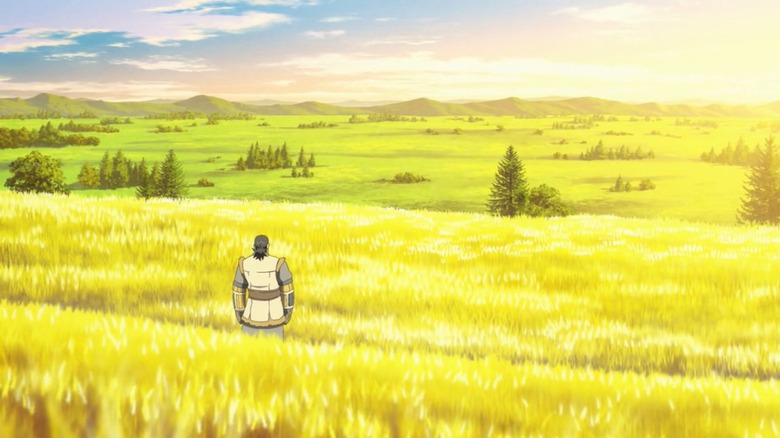What Shogun Has In Common With The Best Anime Of 2023
This article contains spoilers for "Shōgun."
It already feels safe to say that FX's "Shōgun” is the TV breakout of 2024. FX, noticing the comparisons of "Shōgun" to "Game of Thrones," has concluded they have a golden goose and picked up the limited series for two more seasons.
"Shōgun" is set in Japan during the year 1600. Lord Yoshii Toranaga (Hiroyuki Sanada) gains an ally in John Blackthorne (Cosmo Jarvis), a shipwrecked European sailor. Blackthorne came to Japan to ensure the Portuguese didn't seize the island nation before his homeland England could get a trading foothold. When he arrives, he doesn't speak a word of his new companions' language.
One of the first Japanese words that Blackthorne learns is "Teki" — "Enemy." I remember as I watched the scene, I recognized the word myself. I don't speak Japanese, but I have picked up a few words from watching many different anime series. Among them are "Watashi" ("I"), "Sekai" ("world"), "Mirai" ("future"), and "Teki."
That latter, I got from the best anime series of 2023: "Vinland Saga" (sorry "Attack on Titan"). Near the end of season 2, the series' protagonist Thorfinn completes his character development from a vengeful warrior to an idealistic icon with these words: "Ore ni teki nanka inai" — "I have no enemies."
"Vinland Saga" is set in the 11th century during Viking dominance of Europe. Vikings and Samurai are cross-cultural equivalents (which makes it extra funny to hear the former speaking Japanese), and what links "Vinland Saga" and "Shōgun" is their cultural bridges. "Shōgun" is a Japanese epic written by an Englishman (James Clavell, author of the original novel). Blackthorne stands in for Clavell in his journey to understand Japanese culture from the outside. "Vinland Saga" is a Viking epic written by Makoto Yukimura, a Japanese man, and has insights only an outsider could glean.
How Shōgun avoids orientalism
"Shōgun" is an American production with a white man in a lead role, but it doesn't fall into orientalist traps. This comes down to people making it; co-creator Rachel Kondo is a Japanese-American, Sanada is a producer, and the majority of the cast is Japanese. Thus, the show depicts the Japanese from the inside whenever possible.
An amusing bit of characterization is how the Japanese characters view Blackthorne as a "barbarian" in the same way he views them; they are not exotic discoveries by a white explorer, but fellow humans with a culture deserving of respect. "Shōgun" follows through by rendering most of its dialogue in Japanese, thereby conveying the most essential aspect of the Japanese culture (how they communicate) while not presenting English as a universal language with precedent over others.
That's not to say European influence hasn't seeped into Japan, even in 1600. A handful of the Japanese characters in "Shōgun" — both nobles and peasants — are Christian converts, even if they fail to grasp the difference (and hatred) between a Protestant like Blackthorne and the Catholic Portuguese. Lady Mariko (Anna Sawai) is the most prominent Japanese Catholic in "Shōgun." As a testament to her faith, her Romanized name is Maria, the name that once belonged to the mother of God.
Within religion lies the most dramatic culture clash. In feudal Japan, seppuku (ritualized suicide) is a common practice to restore lost honor to one's self or family. In Christianity, though, suicide is a mortal sin that guarantees damnation; after all, it's the only type of murder for which you can never be absolved of in life. Mariko, ordered by Toranaga into a suicide mission to undermine his enemies, wrestles with this question in episode 9 ("Crimson Sky"). Which Lord must she obey; her feudal Lord or her Lord, God our Father?
Vinland Saga recreates medieval Europe with a Japanese eye
Every line drawing of "Vinland Saga" begins with Yukimura's pencils. He took his duty in recreating medieval Europe seriously, reading ancient Icelandic texts and visiting countries including Denmark and England (it's easier to draw a place you've actually stepped foot in).
Yukimura's research shows in the detail with which he creates his setting out of history. He weaves in real European history, such as the lingering Roman influence on the continent and the rise of the North Sea Empire ruled by King Canute the Great. Episode 6 of the "Vinland Saga" anime, "The Journey Begins" opens by recapping the history of the Danish invasions of England. The sequence ends with ravens, a bird associated with the Norse God Odin, plucking meat from a field of dead English soldiers. The symbolism could not be more obvious, yet it could only have come from an educated artist.
Since Yukimura writes with a Japanese audience in mind, though, he relates this history with the view of someone unfamiliar with it. The back pages of each manga volume have a map of the European continent (with a line tracing the geography of Thorfinn's journey to that point). Inside those pages, there'll be notes explaining how, for instance, European farming methods (as depicted in the art) differ from Japanese ones.
There are some common cultural ideas though, such as the notion of honorable death (Vikings believed one must die in battle to achieve eternal rest in Valhalla). Episode 21, "Reunion," features the wounded Viking Bjorn asking his leader, Askeladd, to kill him in a duel so he can die a Viking's death. The scene carries the same stakes as any seppuku scene in "Shōgun," with killing done not out of hatred, but friendship and respect.
Christianity seen from the outside in Shōgun and Vinland Saga
"Shōgun" and "Vinland Saga" share the same cross in the room: Christianity. The Vikings were not Christians, but many of the people they pillaged were, so the religion is still part of "Vinland Saga." This allows Thorfinn to serve as a proxy for Japanese readers who may be unfamiliar with the faith.
In "Vinland Saga" season 2 episode 13, "Dark Clouds," Thorfinn overhears a reading from the Bible, specifically the Book of Matthew passages 5:43-48 ("You have heard that it was said, 'Love your neighbor and hate your enemy.' But I tell you, love your enemies..."). It's clear this passage helps him come to his own realization that "[he has] no enemies."
Parsing Yukimura's apparent perspective on Christianity reveals how, as someone who wasn't raised in it, he can take an objective view. In "Vinland Saga," the humanistic teachings of Christ (from forgiveness to nonviolence against your fellow man) are valuable, but praying to an invisible God to care for you and smite your enemies is absurd.
In season 1 episode 14, "The Light of Dawn," an English family talks around their dinner table about how Christ will come again to destroy nonbelievers, before Askeladd's Viking band barges in and slaughters them. It's hard to get a harsher damnation of provincial, misapplied Christian thought than that! Canute, a rare Viking Christian, builds his empire with the intent of building the Earthly paradise that God refuses to give his subjects.
The historical feminism of Shōgun and Vinland Saga
"Shōgun" ends with an anticlimax that demonstrates how sometimes, wars are won by political maneuvering, not on the battlefield. "Vinland Saga" is conversely the more battle-filled and explicitly anti-war of the two series. Thorfinn's arc is about unlearning toxic masculinity in a culture that values it. Even so, both shows have a theme of how it's women who pay the price when men start wars.
Mariko does fulfill her duty and dies to help Toranaga defeat his rivals. A woman doing a man's job of ending a war; is this what equality looks like? Furthermore, Lady Usami Fuji (Moeka Hoshi) finds herself as Blackthorne's assigned consort after her husband and infant son are both put to death via seppuku. Violence doesn't only affect those whose lives it takes, and historically women (who were barred from serving as soldiers) had to reap the consequences of poverty or servitude when their husbands died.
Compare Fuji to Arnheid from "Vinland Saga," an enslaved woman whom Thorfinn meets on a Danish plantation. She was once a happy wife and mother until her husband Gardar went off to fight a battle for wealth they didn't need — and lost. In the present, Arnheid is reduced to her enslaver's comfort woman; when Gardar tries and fails to rescue her, she's punished with a lethal beating.
No matter what side of the world you live on, this is a man's world.
Sailing the world, from Japan to Vinland
Japan as seen in "Shōgun" is no weak nation ready to be picked off by European imperialists. (Follow history and you'll read how Japan instead became isolationist and then an empire itself at the Meiji restoration of the late 19th century.) Even so, the Europeans are there because they want to gain a foothold in Japan, lest their national rivals do so first. Colonialism is a zero-sum game and "Vinland Saga," with its many brutal scenes of Viking raids, shows how barbarically that game can be played.
"Vinland Saga" is titled as such because "Vinland" is what the Vikings called North America (the first European to reach the West was Leif Erikson). Thorfinn's goal, cemented at the end of season 2, is to build a country free from war and slavery in Vinland. He finally does so in the fourth and to-be final arc of the manga, "Thousand Year Voyage" (which I desperately hope will be animated one day should the anime continue). It's not so easy, though, because there are already native people living in Vinland. Where different tribes of people bloom, so does conflict.
"Shōgun" and "Vinland Saga" both show how even as an outsider to a culture, it's possible to tell its tale with respect — despite how these shows' characters don't always live up to the example of their authors.
"Shōgun" is streaming on Hulu and Disney+. "Vinland Saga" is streaming on Netflix and Crunchyroll.
